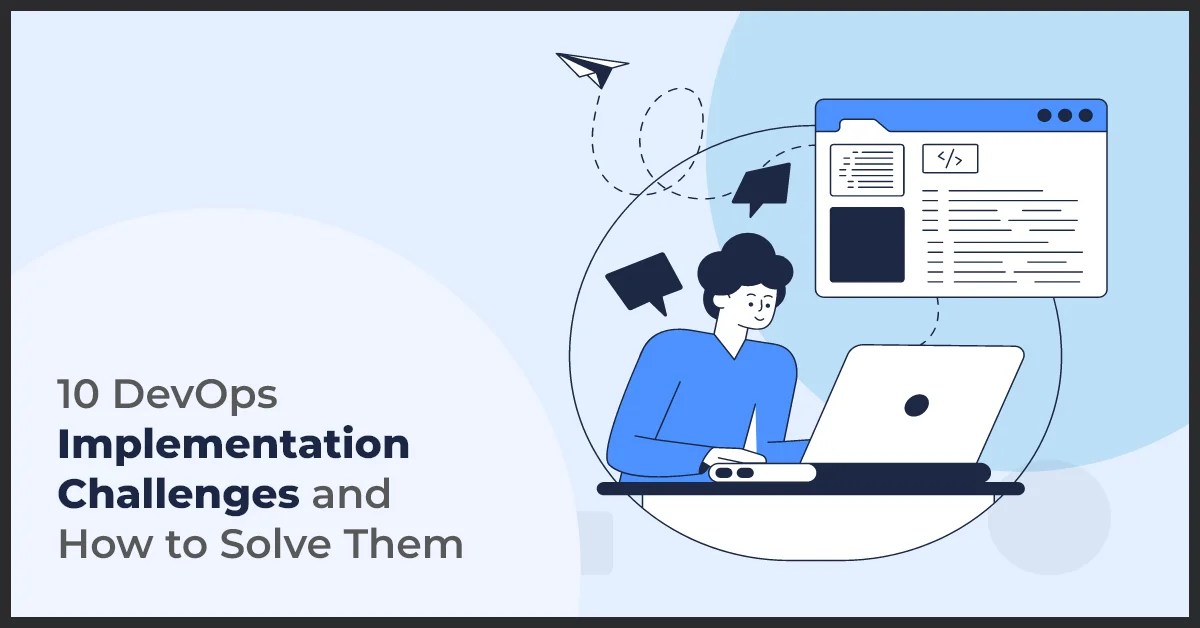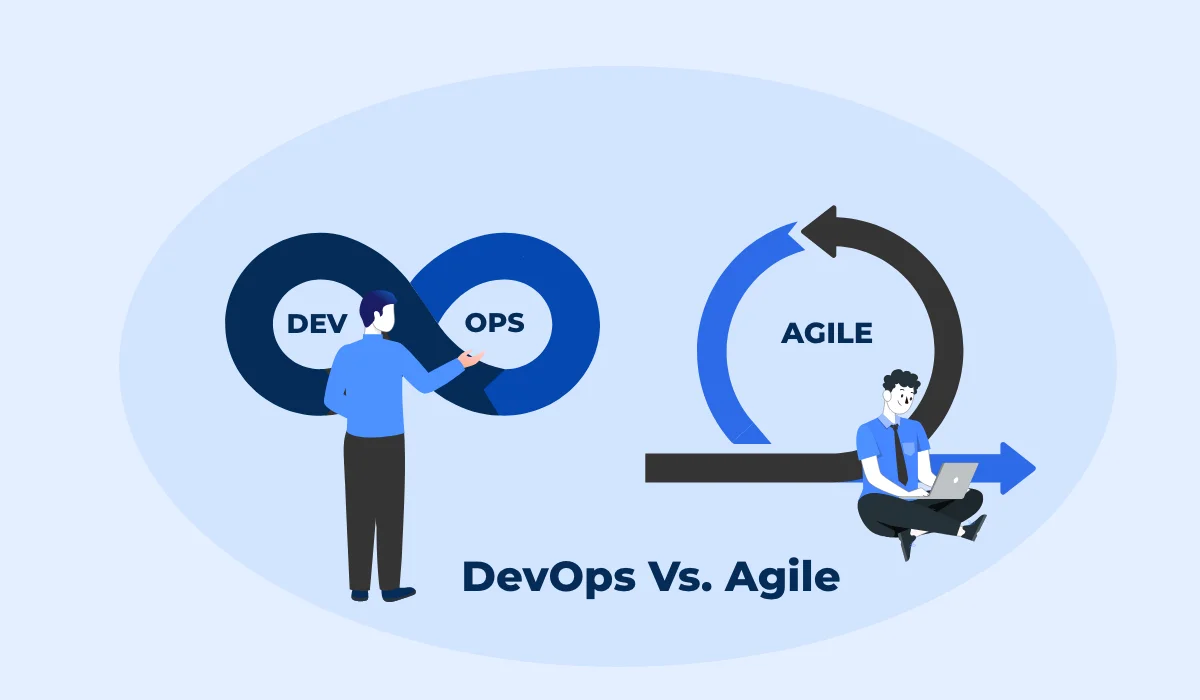10 DevOps Implementation Challenges and How to Solve Them

Published on: November 11, 2022
Updated on: April 14, 2024
343 Views
- Devops
8 min read
If you ask 10 people for the definition of DevOps, do not be surprised if you get 10 different answers! And therein lies the problem. While companies try to implement it (which is not bad), not everybody gets it.
Organizations rush into implementing DevOps without completely understanding how it works. The result? Poor implementation and not the desired results.
This article highlights the most common DevOps implementation challenges most organizations face and how they can smoothly sail these troubled waters (PS: Growth Natives can help you, too!).
1. The Transition from Legacy Applications to Microservices
Most organizations use legacy applications, which are ineffective, incompatible, and expensive to maintain. You cannot have the latest technology and invariably proper implementation of DevOps on systems plagued with such performance issues.
Replace legacy infrastructure and applications with the latest microservices architectures for faster innovation and development. But this move to microservices has its own challenges, the most prominent being complexity.
How to Solve
Infrastructure-as-a-service for data storage and the latest hardware server is a cost-effective way to drive your business processes. When DevOps is combined with microservices,
- they complement each other
- expedite the process of adoption, and
- promote innovation and experimentation.
When companies transition to DevOps, they can solve most of these challenges with automation, continuous delivery, and configuration management. They can help you manage the growing operational workloads tied to microservices architectures.
2. Implementation Costs or Budgets
Some organizations think of DevOps as a means to reduce costs. But that is not the aim of this methodology. On the contrary, DevOps helps achieve higher revenue since you can deliver more value to your clients.
Studies indicate organizations adopting Agile and DevOps report a 60% increase in revenue and profit. But DevOps implementation involves costs and specialized resources, which companies do not consider beforehand.
How to Solve
You must plan ahead and only transition if you have the required resources. Do not go for a halfway implementation, as it will result in more friction and challenges.
The truth is DevOps requires a budget; unfortunately, there is no workaround if you have none.
3. Adoption and Integration of New Tools
Your development team and IT operations use different tools and metrics to track performance. Bringing them together on new software or integrating their existing tech stack is a huge challenge.
For example, it can be overwhelming to decide on a tool that meets your security requirements and is easy to integrate with existing infrastructure. Add to it: the lack of knowledge.
Another challenge is training everyone on the new tools to ensure team productivity is not compromised.
How to Solve
Choose tools that align with your goals and the products you want to build. No point in sticking to legacy systems that slow you down.
Look for the right orchestration tools that can automate tool environments. Such automation will improve communication and increase transparency between the development and operations teams. It will lower time-consuming tasks like data entry, product research, and analysis.
Further, automation streamlines the development lifecycle by blending various departmental processes into one.
4. Security and Governance Issues
Software development and IT operations teams have different goals. While the former works towards time-to-market, the latter ensures reliability, security, governance, and availability. Therefore, a quick deployment in DevOps may cause teams to overlook security and governance policies, which can be detrimental.
How to Solve
Companies can avoid this lapse by applying Release Automation (ARA), which ensures quick deployment and automation of security and compliance policies. Moreover, business should look at creating a shared goal so that teams work together instead of in silos.
5. Managing Multiple Environments
As the complexity of your application increases, it will create a need for separate staging, development, production, and test environments. Managing multiple environments is complex and can spiral out of control without a defined series of predetermined steps.
How to Solve
Ask your DevOps team to build a plan that identifies all the steps that accelerate deployment by streamlining testing and development.
6. Challenging to Follow a Bottom-Up Approach
Implementation of DevOps should be bottom-up. But like most tools and platforms, organizations make the mistake of imposing it on the developers, which hampers the faster and more frequent delivery of quality software. That is because the developers and not the management know how to get the job done.
How to Solve
Since developers are the ones who know the best way to get the job done, they should be left to decide which platform and tools to use.
7. Resistance to Change
It is usual for people to resist change, even if it is at work. The move to DevOps is no different. Team members to critical stakeholders oppose DevOps due to its complexity. Telling people that they need to change can be scary and off-putting. After all, any digital or technological transformation, including DevOps, does not happen overnight.
How to Solve
Instead of dictating change, embracing DevOps should be posited as an evolution of existing development practices. The step toward change should be slow and smooth until everyone gets on board. Your team should be able to see the various ways this new approach can provide value to the development process.
You can start slow with a small product and remodel it into DevOps practices. Once the teams realize the benefits, other teams will follow suit. It will create a snowball effect and calm the sense of unfamiliarity in the organization.
8. Key Metrics to Track
Data does not lie. Metrics are essential for measuring performance. But sometimes, companies make the mistake of focusing on collecting way too much, pulling them into a vortex of metrics and dashboards. As a result, companies forget to collect basic data.
How to Solve
Remember the reason why you are tracking specific metrics—you want to act on them to further improve your performance. In DevOps, it makes sense to concentrate on collecting the DevOps Research and Assessment (DORA) metrics, which include:
Deployment Frequency—How often do you successfully release to production?
Lead Time for Changes—The amount it takes to commit to getting software into production.
Change Failure Rate—The deployment percentage that causes failure in production.
Time to Restore Service—The duration it takes to recover from a failure in production.
Make these DORA metrics available to teams and get a consensus on how to improve them. This targeted approach will help you deliver and embed the DevOps culture into various teams.
9. Securing Your Infrastructure
The adage, "with big power comes big responsibilities," holds for DevOps since security is crucial. It's so important that it has its own subset called DevSecOps.
On the one hand, digital transformation technologies like artificial intelligence and machine learning require a massive volume of data to give accurate results; on the other hand, legal compliance has to be followed to avoid data breaches.
Therefore, securing DevOps infrastructure while achieving safer and faster deployments is a significant implementation challenge.
How to Solve
While the problem is of great magnitude, DevSecOps offers security considerations at the start of development and deployment. It ensures you can easily detect bugs, mitigate risk, and manage resource costs and legal liability.
Regardless of your company size, earmark a budget for investing in security to avoid data breaches or lapses.
10. Creating a DevOps Center of Excellence
When implementing new technology, often, the knowledge is limited to a few in the team. And when they leave the company or the team, the company realizes the weight of that dependence and struggles to fill the void. Setting up a Center of Excellence (CoE), where the knowledge is transferred to everyone on the team, is essential.
How to Solve
Create a DevOps CoE to document essential knowledge and share it with all who need to know it. Your CoE might be necessary to define and record the best practices and disseminate these valuable learnings to all practitioners.
CoE can help troubleshoot, explore new ways to develop software faster, and so on. Hire professionals who have years of experience with DevOps challenges and solutions.
Tackling DevOps Implementation Challenges the Right Way
This is our list of the 10 most common DevOps implementation challenges and how you can solve them. The list is not exhaustive and can be unique to your unique needs. Unfortunately, there is no one-size-fits-all approach or hacks for perfect implementation.
Your strategy will be unique to you and depend on various parameters. Contact our experts at info@growthnatives.com if you want help for your organization to fully leverage DevOps and grow your revenue.

